Q&A – Ask Neil: March 28, 2024
(Please read these instructions carefully.)
Before you post your question, please look at recent issues to see if someone else has already asked it. You might find your answer there.
How to submit your question…
(Note: You may need to allow a pop-up window to come up in order to get the link for sending your photo(s). If you have already submitted your question and didn’t see the pop-up window, please click here.)
• Click the link provided below to post your question. After you submit your question, a new window will pop up giving you the address to which you can e-mail a SHARP, HIGH-RESOLUTION PHOTO to accompany your question. Please DO NOT SEND THUMBNAIL PHOTOS in case I need to zoom in to see things.
• Click here to post your question.
• Please ONLY POST YOUR QUESTION ONE TIME. We can only accept a set number of questions each week, and when we get duplicates it costs other people their chances.
• One question per reader, please.
• Please use this only for posting questions – not for standard emails.
• Watch for your answer in the following week’s e-gardens.
• I choose those of greatest general interest. For example, plant IDs seldom make the cut.
• I must have your first name or initials.
• I must have your city or county. (Texas is a very large state.)
QUESTION 1
WHY WOULD TWO OUT OF 15 LITTLE GEM MAGNOLIAS HAVE THESE BAD LEAVES?
Question: I have 15 Little Gem magnolias. 13 of them are doing well, but two are in trouble. All are on the east side of the yard. The healthy ones are directly next to the sick ones. The sick trees are sparse and their leaves are half green and half grayish. Barbara T., Tyler.
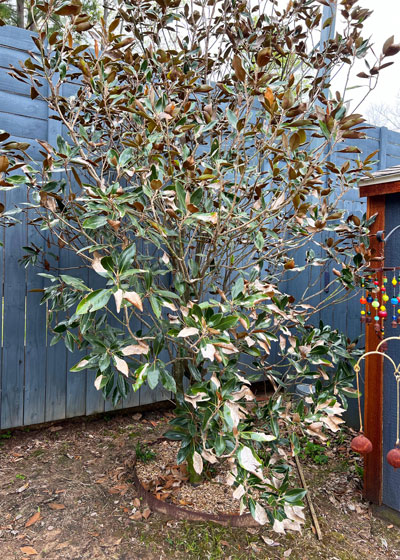
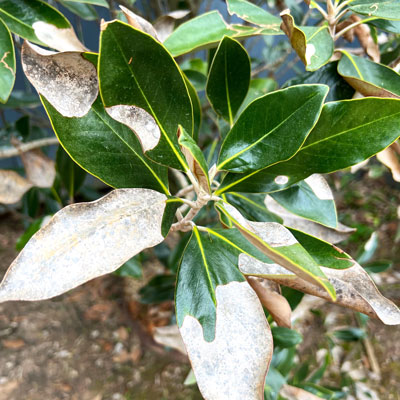
Answer: The leaves show evidence of moisture stress, probably caused by the weeks/months of really dry conditions late last summer. You can see mold on some of the leaves, where there is damage, so you know that this is old trouble. We’re seeing lots of magnolias and Nellie R. Stevens and Oakland hollies showing the same symptoms. (All have large, leathery leaves.) Anytime you see browned or grayed tissue at the edges or tips of the leaves, that’s moisture stress. Those are the places where a tree gets water delivered last and where it runs out first.
Some weed-and-feed fertilizers (containing atrazine) can also damage magnolias, but they tend to cause leaves to roll up tightly. Magnolias are especially susceptible to this damage.
My suggestion is going to be that you wait until your trees drop last year’s leaves and put on new growth before you evaluate their true condition. Fertilize with an all-nitrogen fertilizer any time now and water the trees deeply to get the nutrients to their roots. Just make sure that the fertilizer does not have a weed killer component.
QUESTION 2
SHOULD I REMOVE THESE SHOOTS FROM MY LILY?
Question: We have a tall lily with a thick stalk. It grows to 4 ft. tall and always opens between June 19 and June 21. I just noticed leggy shoots and three stalks coming up. Should I remove any/all of the “extra” shoots/stalks? The photos are from last week and last year. Kati H., Richardson.
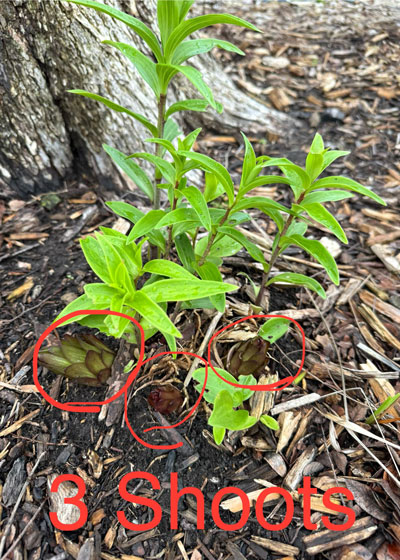

Answer: Don’t remove any of the shoots. If you think back over the past several weeks, many of the flowering trees, shrubs, and vines that we grow in Texas have bloomed two or three weeks ahead of schedule. That is due to a mild late winter and early spring. Your lily is just celebrating the great weather that we’ve had. It’s very likely that it will bloom a couple of weeks earlier than you have observed in the past. There are no calls for worry.
QUESTION 3
I HAVE ALL KINDS OF WEEDS IN MY LAWN. TWO PRIOR APPLICATIONS HAVE NOT GOTTEN THEM ALL. WHAT SHOULD I DO?
Question: I have all kinds of weeds in my lawn. I’ve been to my favorite nursery, and they have recommended a product that is supposed to control scores of types of weeds. Some of the huge ones were still there. I bought another product that made similar claims, but the weeds remained. What should I do now? Olga G-O, Dallas.
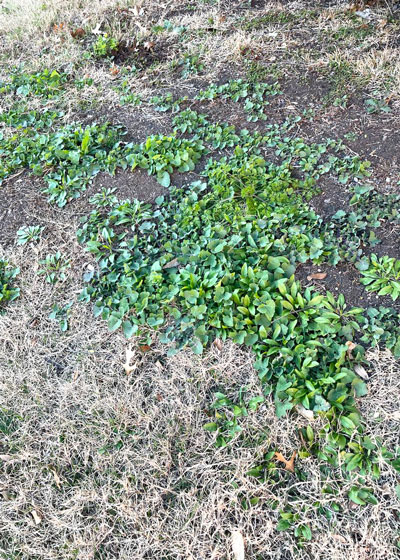
Answer: The weeds in your photo are all broadleafed weeds, meaning that they are not grasses. I would recommend a product labeled for dandelions, clover, poison ivy, chickweed, and wild violets, among many other broadleafed weeds. There are many of them in the marketplace, almost all containing 2,4-D, and many also containing two other active ingredients to make up a blend known as Trimec.
Those products should be used according to label directions. Apply them carefully directly to the weeds’ leaves. Use a spray tank that lets you adjust the nozzle down to a fine droplet size. I prefer to include one drop of liquid dishwashing detergent per gallon of mixed spray to help it stick to glossy and V-shaped leaves (such as wild violets). Be careful not to let the spray drift onto shrubs and flowers since it doesn’t differentiate between various types of broadleafed plants. Do not use your spray tank for anything other than herbicides from that point forward. It is difficult to rinse out the residue of the broadleafed weedkiller spray. Allow the spray several days to do its job before you mow the lawn again.
QUESTION 4
WHAT TYPE OF INSECT IS DOING THIS DAMAGE TO MY CRAPE MYRTLES?
Question: I have a 7-year-old Muskogee crape myrtle which has been doing great so far, even surviving the cold. However, I see some insect damage on the trunks of the tree. Please help me identify the problem. Sawan B., Collin County.
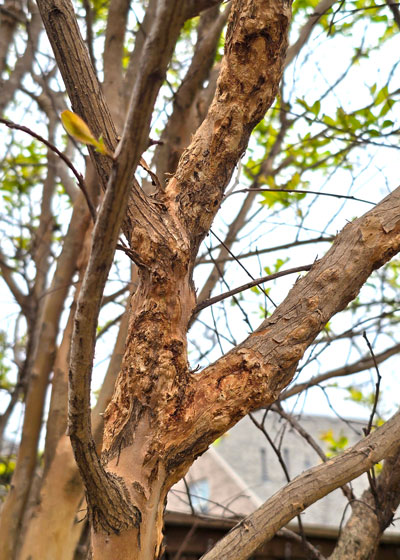
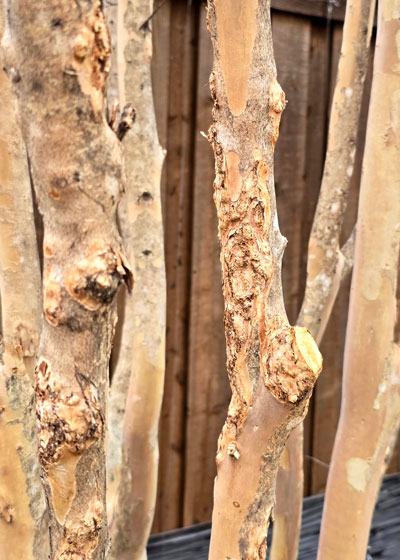
Answer: I must be honest and tell you that I am not sure. I can make no guarantee that my answer is it all accurate. I don’t recall seeing this type of damage before.
It looks like some type of rasping insect that might have scored the tender leaf tissues sometime last growing season. The tree looks like it has tried to heal across those wounds and has developed a series of tiny burls in the process. I would watch those specific stems this spring to see if they leaf out vigorously and if the injured areas continue to heal.
There is also the possibility of a fungus that the Texas A&M plant disease lab identified for me five years ago as the fungus Botryosphaeria. It was a plant sample in a Northern Louisiana cemetery in a memorial planting. As I remember, it had disturbed tissues that look somewhat like this. You might do a little online research to see if you can find anything as a match between the plant genus Lagerstroemia and the fungus Botryosphaeria. I spent about 45 minutes looking, and I did not find anything, but it has to be out there.
You could also send samples of the affected tissues to the Texas A&M Plant Clinic at Texas A&M University, College Station, Texas, and ask them to culture them for you. There will be a charge, and you probably need to fill out forms that you can find on their website.
I hope that helps and I hope you’ll let me know if you do work with A&M and if they have anything to report back to you.
QUESTION 5
I WANT TO RESEED MY LAWN. WHAT IS THE PROCESS?
Question: I want to reseed my lawn. Is bermudagrass best? I used to have St. Augustine, but it burned up last year. I currently have winter rye, but I don’t know the process for reseeding and fertilizing the lawn, also for weed control for new seeds. I applied pre-emergent two weeks ago. PK H, Benbrook.
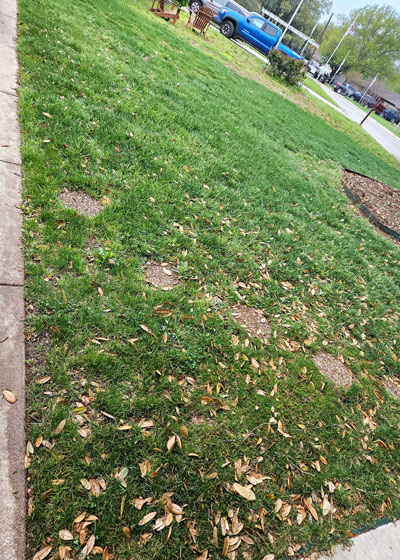
Answer: Let me get my neck straightened up. I’ll address your questions as declarative statements. They may be a bit random.
• Bermuda is our best grass that can be grown from seed. In fact, it’s just about the only good one, so if seeds are what you want, it will need to be bermuda.
• Your St. Augustine may not have “burned up.” I hear that a great deal, and nine times out of 10, the problem is actually damage from chinch bugs. They attack in the hottest part of the summer, and then only in the sunniest, hottest parts of the yard. For people who really prefer St. Augustine, I encourage them to know the early signs of chinch bug invasion and how to control them so that they can continue to grow St. Augustine. It is started, of course, only from sod or plugs.
• You mentioned you applied pre-emergent two weeks ago. That will impact the soil for at least 100 days, so you really can’t plant any new grass, especially from seed, during that time. That messed up the normal scheduling. I wish I could have helped earlier.
Here would be my game plan at this point: Let the ryegrass continue to look good for the next 4 to 6 weeks.
As it gradually thins and dies out from the heat, evaluate how much bermuda you already have. My bet is that you have more than you might expect.
Keep mowing your lawn low (1-1/4 inch) and frequently to encourage it to stay low and dense. If you find that you have, on average, one piece of bermuda the size of a paper clip per square foot of ground, you will be able to get that grass to cover and fill by the end of June just by taking maximum care of your lawn. I have done this at a former church, and even I was amazed.
Normally I would recommend only using a high quality all-nitrogen lawn food with 30 to 40 percent of that nitrogen in slow-release form.
However, we’re going to step on the gas and apply ammonium sulfate (21-0-0) two or three times to get the grass to grow really vigorously. Put 5 or 6 weeks between feedings and be prepared to mow like you’ve never mowed before. This is not a process you’ll want to do ever again. This is “junk food” for a lawn that could lead to long-term problems, but I would try it now just to get the bermuda to cover from its raw beginnings. I think it can work.
QUESTION 6
HOW CAN I DISCOURAGE A YELL0W-BELLIED SAPSUCKER FROM ATTACKING MY LIVE OAK?
Question: How can I discourage a yellow-belied sapsucker from drilling holes in my live oak? It’s a huge tree, and the bird is riddling it with holes. Will it harm the tree? Kathy M., Waco.

Answer: I have sapsuckers and woodpeckers all over my live oaks, red oaks, Chinquapin oaks and pecans on our 11 acres. There are times it sounds like a fife-and-drum concert with the fifes on strike. I have never seen them do any damage to the trees in 47 years of living with them around us, even though there are trees with dozens of rows of holes around their trunks. But I have had damage to three tree-form yaupon hollies and two of my big Nellie R. Stevens hollies. Their bark seems to be thinner and less able to re-cover in the wounded areas. I have used paper tree wrap to protect them, and I’ve even bought Tree Tanglefoot to coat the trunk of one Nellie R. Stevens holly, although I never used it.
QUESTION 7
HOW CAN I PREVENT RESCUEGRASS?
Question: My lawn is infested with rescuegrass and annual bluegrass. Will the same pre-emergent prevent rescuegrass? Is rescuegrass developing resistance to the pre-emergent products? Do I need to apply on the same schedule? Can glyphosate be sprayed on dormant lawns? Mark M., Bexar County.
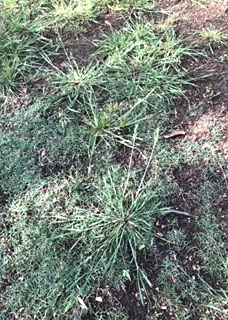
Answer: I’m going to have to take your word that that is rescuegrass. I tried to zoom in to enlarge the photo, but there isn’t enough resolution. It’s obviously a cool-season weed (grows in winter and early spring). If it dies completely and starts over again in the fall from seeds and not from roots of an old clump, yes you can use the same products and timing. I’m not aware of other grasses (other than Poa annua, annual bluegrass) that have developed any resistance to Dimension, Balan, and Halts applied in the last week of August or the first week of September. Finally, in theory you could apply a glyphosate spray to a dormant bermuda lawn, but as far south as you are, I doubt if you’ll have completely dormant bermuda very often. I would not recommend trying that spray – too much risk of damaging the runners. In your case in the photo, you could easily take the clumps out with the corner of a well-sharpened hoe when the soil is relatively dry.
